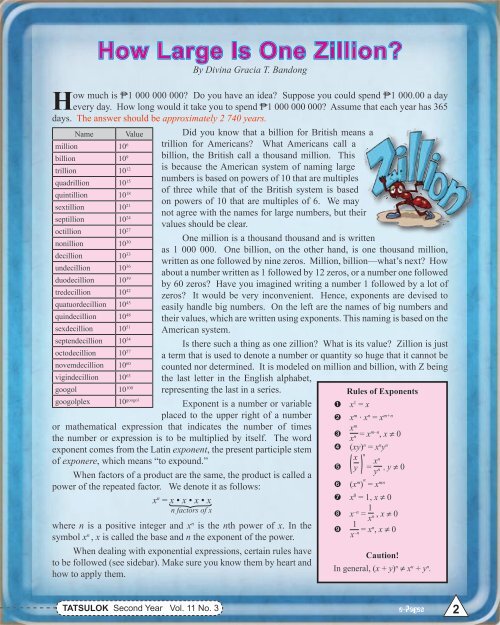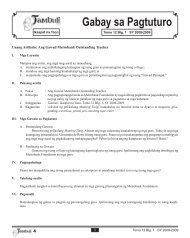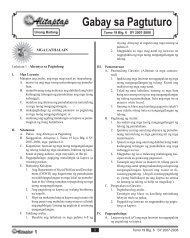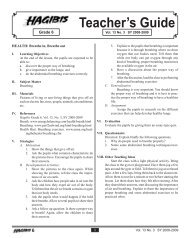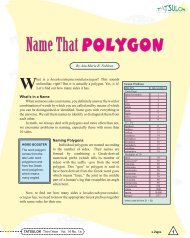How Large Is One Zillion? - Diwa Learning Systems
How Large Is One Zillion? - Diwa Learning Systems
How Large Is One Zillion? - Diwa Learning Systems
You also want an ePaper? Increase the reach of your titles
YUMPU automatically turns print PDFs into web optimized ePapers that Google loves.
<strong>How</strong> <strong>Large</strong> <strong>Is</strong> <strong>One</strong> <strong>Zillion</strong>?<br />
By Divina Gracia T. Bandong<br />
<strong>How</strong> much is 1 000 000 000? Do you have an idea? Suppose you could spend 1 000.00 a day<br />
every day. <strong>How</strong> long would it take you to spend 1 000 000 000? Assume that each year has 365<br />
days. The answer should be approximately 2 740 years.<br />
Name Value<br />
million 106 billion 109 trillion 1012 quadrillion 1015 quintillion 1018 sextillion 1021 septillion 1024 octillion 1027 nonillion 1030 decillion 1033 undecillion 1036 duodecillion 1039 tredecillion 1042 quatuordecillion 1045 quindecillion 1048 sexdecillion 1051 septendecillion 1054 octodecillion 1057 novemdecillion 1060 vigindecillion 1063 googol 10100 TATSULOK Second Year Vol. 11 No. 3<br />
Did you know that a billion for British means a<br />
trillion for Americans? What Americans call a<br />
billion, the British call a thousand million. This<br />
is because the American system of naming large<br />
numbers is based on powers of 10 that are multiples<br />
of three while that of the British system is based<br />
on powers of 10 that are multiples of 6. We may<br />
not agree with the names for large numbers, but their<br />
values should be clear.<br />
<strong>One</strong> million is a thousand thousand and is written<br />
as 1 000 000. <strong>One</strong> billion, on the other hand, is one thousand million,<br />
written as one followed by nine zeros. Million, billion—what’s next? <strong>How</strong><br />
about a number written as 1 followed by 12 zeros, or a number one followed<br />
by 60 zeros? Have you imagined writing a number 1 followed by a lot of<br />
zeros? It would be very inconvenient. Hence, exponents are devised to<br />
easily handle big numbers. On the left are the names of big numbers and<br />
their values, which are written using exponents. This naming is based on the<br />
American system.<br />
<strong>Is</strong> there such a thing as one zillion? What is its value? <strong>Zillion</strong> is just<br />
a term that is used to denote a number or quantity so huge that it cannot be<br />
counted nor determined. It is modeled on million and billion, with Z being<br />
the last letter in the English alphabet,<br />
representing the last in a series.<br />
Rules of Exponents<br />
Exponent is a number or variable<br />
placed to the upper right of a number<br />
or mathematical expression that indicates the number of times<br />
the number or expression is to be multiplied by itself. The word<br />
exponent comes from the Latin exponent, the present participle stem<br />
of exponere, which means “to expound.”<br />
When factors of a product are the same, the product is called a<br />
power of the repeated factor. We denote it as follows:<br />
xn googolplex 10<br />
= x • x • x • x<br />
n factors of x<br />
googol<br />
where n is a positive integer and xn is the nth power of x. In the<br />
symbol xn , x is called the base and n the exponent of the power.<br />
When dealing with exponential expressions, certain rules have<br />
to be followed (see sidebar). Make sure you know them by heart and<br />
how to apply them.<br />
➊ x1 = x<br />
➋ xm · xn = xm+n ➌ xm<br />
x n = x m–n , x ≠ 0<br />
➍ (xy) n = x n y n<br />
➎ ( x<br />
n<br />
y ) = xn<br />
yn , y ≠ 0<br />
➏ (xm ) n<br />
= xmn ➐ x0 = 1, x ≠ 0<br />
➑ x –n = 1<br />
xn , x ≠ 0<br />
1<br />
➒<br />
x –n = xn , x ≠ 0<br />
Caution!<br />
In general, (x + y) n ≠ xn + yn .<br />
e-Pages<br />
2
The preceding rules of exponents are used when we want to simplify an algebraic expression. A<br />
combination of these rules may be applied in simplifying a single expression. <strong>How</strong> do we know if the<br />
expression is already in simplified form? Bear these in mind.<br />
➊ There should be no grouping symbols. ➍ Each factor has a single positive integral exponent.<br />
➋ There should be no negative or zero exponents. ➎ Each factor or variable appears only once in the expression.<br />
➌ The fractional coefficient is in lowest term.<br />
=<br />
=<br />
=<br />
22 x2 2<br />
)<br />
3 2<br />
=<br />
2 ___________________<br />
xn<br />
yn (22 ) 2 ( x2 )<br />
9<br />
24 =<br />
4 x<br />
(x<br />
___________________<br />
9<br />
4 16 x<br />
___________________<br />
m ) n<br />
= xmn Exercise 1<br />
( 6x<br />
8x3 2<br />
2 · 3 · x<br />
) = ( 23 x3 2<br />
) ___________________<br />
= (21–3 · 3 · x1–3 ) 2<br />
___________________<br />
= (2 –2 · 3x –2 ) 2<br />
___________________<br />
= ( 3<br />
3(27a<br />
___________________<br />
2b –3 ) –2<br />
(9a4b3c0 )<br />
= 3(33a2b –3 ) –2<br />
(32a4b3c0 ) ____________________________<br />
= 3(3 –6a –4b6 ) (32a4b3 ) ____________________________<br />
= 31+(–6)+2a –4+4b6+3 ____________________________<br />
= 3 –3a0b9 Can you justify each step in the following simplification? Write the procedure used or the rule/s<br />
of exponents applied in each step.<br />
x<br />
____________________________<br />
m<br />
xn = xm–n , x ≠ 0<br />
x –n = 1<br />
xn (x<br />
, x ≠ 0<br />
m ) n<br />
= xmn and x0 = 1, x ≠ 0<br />
xm · xn = xm+n ( x<br />
y ) n<br />
Exponents are used in writing a number in scientific notation. Scientific notation is a shorthand<br />
way of writing very large or very small numbers. As the name suggests, scientific notation is especially<br />
useful to scientists in writing or reading extremely large or small numbers since writing numbers in<br />
scientific notation allows them to leave out a number of zeros while retaining some indication that the<br />
zeros exist.<br />
A number x is written in scientific notation as a number between one and 10 multiplied by a specific<br />
power of 10. In symbols,<br />
x = a × 10 n where 1 < a < 10 and n is an integer<br />
<strong>How</strong> do you express a number in scientific notation? Simply move the decimal<br />
point up to a number between one and 10. Then, count the number of places in<br />
which you moved the decimal point. This becomes the power of 10 in the scientific<br />
notation. A large number is written in scientific notation with a positive power of 10<br />
while a very small number takes a negative power of 10. This means that when you<br />
move the decimal point to the left, the exponent of 10 is positive, while a negative<br />
exponent is used if you move the decimal point to the right. Look at this example.<br />
Example:<br />
Scientists have defined the speed of light in a vacuum to be approximately<br />
300 000 000 meters per second. This is written in scientific notation as:<br />
300 000 000 = 3 × 10 8<br />
8 places<br />
TATSULOK Second Year Vol. 11 No. 3 e-Pages<br />
b 9<br />
3 3<br />
x –n = 1<br />
____________________________<br />
xn , x ≠ 0 and x0 = 1, x ≠ 0<br />
3
ACROSS<br />
2. (a8 ) 20<br />
· a8 = a ???<br />
x3y –2<br />
x –6 y2 = x?<br />
y ?<br />
4.<br />
(2z<br />
6.<br />
–3 ) –2<br />
z8 (–z5 ) 6 = 1<br />
4z ??<br />
1<br />
7.<br />
(3 –2 2 = ??<br />
)<br />
8. (2 · 4 · 8 · 16) 2 = 2 ??<br />
3(2a)<br />
9.<br />
6<br />
(2b) 3 = ??a6<br />
b3 12. [3(2xy) 2 ] 2<br />
= ???x 4 y4 15. 9x+2<br />
= ??<br />
2x 3<br />
1<br />
17.<br />
0 + 20 + 30 + 40 + 50 (–2) –2 = ??<br />
18. (x2yz0 ) 2 · y = x ? y ?<br />
(2x<br />
20.<br />
2 )(5x –3 )<br />
(3x) –1 = ??<br />
21. 0.00000000060 = 6 × 10 ?<br />
22. (ab2c3 ) 2 (a –2b –1c) –2<br />
= a ? b ? c ?<br />
DOWN<br />
1. 4.1 × 10 –6 = ?????????<br />
2. 5(a 2 – b 2 ) = ??? if a = 5 and b = 1<br />
3. 820 000 000 = ??? × 108 4 · 73<br />
4. = ??<br />
14<br />
5. 4.1 × 108 = ?????????<br />
6. (xy2 ) 2<br />
= ?? if x = –2 and y = –3<br />
10. 3(2z8 ) 2<br />
· 4z -16<br />
= ??<br />
Exercise 2<br />
Let’s see how well you work with exponents. Complete the following number puzzle. Solve the<br />
given problems below. A question mark represents a digit or a decimal point. A single digit or a decimal<br />
point occupies one box in the grid. The digits/decimal point are written on the grid in the same order that<br />
they are written in the expression. If the missing digits are written from top to bottom, write them in the<br />
grid from left to right or from top to bottom.<br />
1 2 3 4 5<br />
6 7<br />
8 9 10<br />
12<br />
11<br />
13 14<br />
15 16 17<br />
18 19 20<br />
21 22<br />
11. [ 49(3u2v) 3<br />
63 ]<br />
(3x)<br />
13.<br />
2<br />
(2y) –1 = ??x2y 14. 3 × 102 = ???<br />
2<br />
= ???u 12 v 6<br />
16. 0.00016 = ??? × 10 –4<br />
17. a –1 (b –3 )c · (ab 2 c) 3 = a ? b ? c ?<br />
19.<br />
9 × 10 5<br />
3 × 10 4 = ??<br />
TATSULOK Second Year Vol. 11 No. 3 e-Pages<br />
4
Answers to Exercises<br />
<strong>How</strong> <strong>Large</strong> <strong>Is</strong> <strong>One</strong> <strong>Zillion</strong>?<br />
Exercise 1<br />
A. Factoring<br />
xm xn = xm–n , x ≠ 0<br />
Addition of Integers<br />
x –n = 1<br />
xn , x ≠ 0<br />
( x<br />
y ) n<br />
= xn<br />
y n<br />
(xm ) n<br />
= xmn Expanding the power<br />
B. Expressing numbers in terms of<br />
exponents<br />
Exercise 2<br />
(xm ) n<br />
= xmn and x0 = 1, x ≠ 0<br />
x m · x n = x m+n<br />
Addition of integers<br />
x –n = 1<br />
x n , x ≠ 0 and x 0 = 1, x ≠ 0<br />
1 2 3 4 5<br />
0 1 6 8 9 4<br />
6 7<br />
. 3 2 . 8 1<br />
8 9 10<br />
0 2 0 2 4 0<br />
12<br />
11<br />
0 4 4 8 0<br />
0 1 4 4 0<br />
13 14<br />
0 1 1 3 0<br />
15 16 17<br />
0 8 1 2 0 0<br />
18 19 20<br />
4 3 . 3 0 0<br />
21 22<br />
1 0 6 4 4 0<br />
Factor In<br />
Answer to the Preliminary Problem:<br />
0, one of the factors is (x – x) = 0<br />
TATSULOK Second Year Vol. 11 No. 3 e-Pages<br />
I.<br />
1. Factor = 3ab (a2 – 3ab + 9b) 2<br />
2. Factor = (m – n)(3m – 1)<br />
3. Factor = 4(u – 1)(2 – v)<br />
II.<br />
(1) To factor x2 + 5x + 6, I need two numbers that add<br />
up to 5 and have a product of 6.<br />
Thus, x2 + 5x + 6 = (x + 5)(x + 1).<br />
(2) To factor x2 – 2x – 3, I need two numbers that add<br />
up to –2 and have a product of –3.<br />
Thus, x2 – 2x – 3 = (x – 3)(x + 1).<br />
(3) To factor x2 – 8x + 15, I need two numbers that<br />
add up to –8 and have a product of 15.<br />
Thus, x2 – 8x + 15 = (x – 3)(x – 5).<br />
III.<br />
1. (x + 7) and (x + 4)<br />
2. (x + 3) 2<br />
3. (x + 4) and (x – 1)<br />
4. (4x – 1) and (3x – 4)<br />
5. a b<br />
c<br />
d<br />
8


